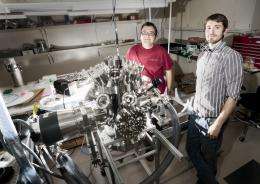LCLS helps create order from chaos

In the world of physics, where everything tends toward disorder, researchers working on the Linac Coherent Light Source are seeking perfect order. Many experiments at the pioneering machine will require each molecule in a puff of gas to align with all of the others, creating a uniform field of molecules on which tests can be conducted.
According to James (Mike) Glownia, a graduate student at the PULSE Institute for Ultrafast Energy Science, "getting all the molecules to align is seriously difficult when you have a cloud of molecules all doing their own thing."
Yet, using a toolbox of techniques, a team of researchers including Glownia managed to do just that for the first time at the LCLS last October. Into a chaotic cloud of nitrogen molecules, the researchers sent a short burst of polarized infrared laser light, which has an intrinsic extra "directionality" at right angles to the laser's direction of travel. Each molecule felt the kick of this polarization, which caused the molecule to rotate in the direction of the laser's polarization.
For a very brief moment, all of the molecules were perfectly aligned in the gas cloud. But then, just a few hundred femtoseconds later, they were again out of whack. Because the molecules were originally oriented randomly, each needed to rotate at a different speed for them all to become aligned at the same moment. The molecules didn't stop rotating after they became aligned; they kept on spinning at their individual speeds, falling right back into what looks like chaos.
"Fortunately, the physics works out such that they all align again for a split second a bit later; that's when we send in the LCLS pulse to take our measurements," Glownia said.
"It's a significant challenge to time the infrared laser pulse with the LCLS pulse," he continued."You need to get timing exactly right, which we were able to do with the help of [SLAC's] Joe Frisch and a timing system that synchronizes the pulses developed by Berkeley Lab."
In the first LCLS experiment requiring this careful configuration, researchers aligned the molecules in a cloud of nitrogen gas with the infrared laser, and then sent in the LCLS X-ray beam to look at a process called Auger decay. Auger decay occurs in hollow molecules—molecules that are missing electrons in the core of one or more of their atoms. In either case, electrons orbiting the molecule's nuclei will drop down to fill the hole, in the process transferring some of their energy to outer electrons. With this added boost of energy, these outer "Auger electrons" zip out of the molecule and into a waiting detector.
In the recent experiment, researchers wanted to see whether the ejected electrons tended to come flying out of the molecule in the same direction, or whether it's at random. Because the team doesn't have a detector that surrounds the sample 360 degrees, they repeated the experiment three times, each time slightly changing the polarization of the infrared laser. This caused the molecules to orient in a different direction, so that the stationary detector saw Auger electrons emitted at a different angle each time.
So far, analysis has revealed that the emission does indeed vary by angle, which Glownia said means there are some interesting electron dynamics going on inside the molecule. The researchers are now in the process of deducing the electron orbital shapes and the physical processes that cause the Auger electrons to favor one direction over another.
In addition to proving the LCLS team's mettle at highly time-dependent experiments, this was the first "pump-probe" experiment undertaken at LCLS. "We're learning new ways to use this machine," Glownia said, "and the data is beautiful."
Provided by SLAC National Accelerator Laboratory





















